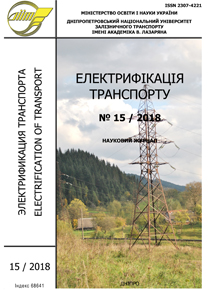Efficiency of the use of linear polymer insulators in the combination with glasses
DOI:
https://doi.org/10.15802/etr.v0i15.155700Keywords:
polymer insulator, plate type insulator, electric field strength, electric aging, diagnosticsAbstract
At present, linear polymeric insulators with an silicone protective shell are perceived as alternative to traditional insulators practical for all classes of AC and AC voltage lines around the world. However, today, the problem of estimating the remaining life of insulators in real time is still unsolved, which would allow timely repair work or replacement of critically damaged insulators. Despite the fact that various methods and tools for diagnosing composite insulators are currently being tested, the methods for estimating the remaining term of safe isolation work are still not formalized in the form of recommendations of the International Committee for Standardization.
The paper deals with an insulating suspension for a high-voltage power transmission line from a polymer insulator supplemented with a plate-type insulator. Sequentially joined disk insulators not only equalize the potentials along the entire suspension, respectively, reduce the maximum field strength of the polymer insulator, but also serve as an indicator of hidden electrical processes in the polymer insulator.
References
EPRI Survey of Application of Overhead Transmission Line Polymer Insulators in North America & Summary of EPRI Polymer Insulator Failure Database. Wold Conference & Exhibition on Insulations, Arresters & Bushings. Marbellu, Spain. 2003. P. 147-157.
Jim H. Duxbury. A Conservative Approach Toward Composite Insulators at BC Hydro: Current Factors and Future Considerations. Wolds Insulator Congress & Exhibition. Shanghai, China. 2001. рр. 79-83.
Kravchenko V.A., Solomonik E.A.. Razrabotka, izgotovlenie, opit ekspluatatii i izgotovlenie polimernix izolatorov dlya VL i podstantii napryazeniem 35-500 kV v Rossii.//Mezdunarodnaya nauchno-texnicheskaya konferentia. Sankt-Peterburg. 2006.
EPRI. Development of a Tool to Assess the Electrical Condition of Composite Insulators Prior to Live Work. www. epri. com, Product ID 1014572, 11/1/2006
F. Schmuck, J. Seifert, I. Gutman, A. Pigini: “Assessment of the condition of overhead line composite insulators“, Paris, CIGRE-2012, b2-214.
A. Pigini: “HV Composite Insulators Today: Market Size & Reliability.” INMR Issue 91, Quarter One, 2011, Volume 19, Number 1.
CIGRE WG 22.03: “Review of “In service diagnostic testing” of composite insulators”, ELECTRA, No. 169, December 1996, p.p. 105-119.
G. H. Vaillancourt, S. Carignan, and C. Jean, “Experience with the detection of faulty composite insulators on high voltage power lines by the electric field measurement method,” IEEE Trans. Power Delivery, vol. 13, no. 2, pp. 661-666, Apr. 1998.
A.s., SSSR. Girlyanda izolyatorov dlya kreplenia i izolyatii provodov/ E.D. Kim, V.N. Solomatov, Y.N. Yashin, N.F. Tarasova, V.A. Aksenov.-SU1607628 A-1 H01 B17/04 ot 05.12. 1988.
Qing Yang, Rui Wang, Wenxia Sima, Tao Yuan and Lei Liao: “Improvement of the Electric Field Distribution around the Ends of Composite Insulator with Series Connection of Glass Insulator” Przegląd Elektrotechniczny, ISSN 0033-2097, R. 89 NR 1b/2013, pp. 248-252.
Jialong Wang*, Yannan Chen, Jintao Liao, Zongren Peng: “Voltage and E-field Distribution of UHV Composite Insulator with Connection of Porcelain Insulators” ISBN: 978-1-4799-8903-4 2015 IEEE 11th International Conference on the Properties and Applications of Dielectric Materials (ICPADM) pp. 628-631.
Kim En Dar, G.V. Sichenko, V.L. Kalmikov. Issledovanie elektricheskogo polya polimernix izolatorov s vnutrennim elektricheskim defektom/Zaleznichnii transport Ukraini-2007-№5-С.61-63
Kim E.D., Kalmikov V.L., Rozov V.A., Demidov O.A. Steklyannii izolator kak indikator vnutrennego sostoyania polimernogo izolatora./Energetika ta elektrifikatia/-2009.-№4.-С. 29-33.
Published
Issue
Section
License
При направленні статті в редакцію, автор гарантує, що стаття надається для публікації уперше і раніше не була опублікована в інших виданнях повністю або частково.
Підписанням ліцензійного договору автор(и) підтверджує(ють), що має(ють) виняткове авторське право на статтю і передає(ють) невиняткові права на свою статтю видавництву журналу «Електрифікація транспорту» для публікації в черговому номері журналу. Автор(и) так само дає(ють) згоду на передачу і розміщення електронної версії своєї статті на сайтах баз даних, створюваних і поширюваних через Інтернет.
